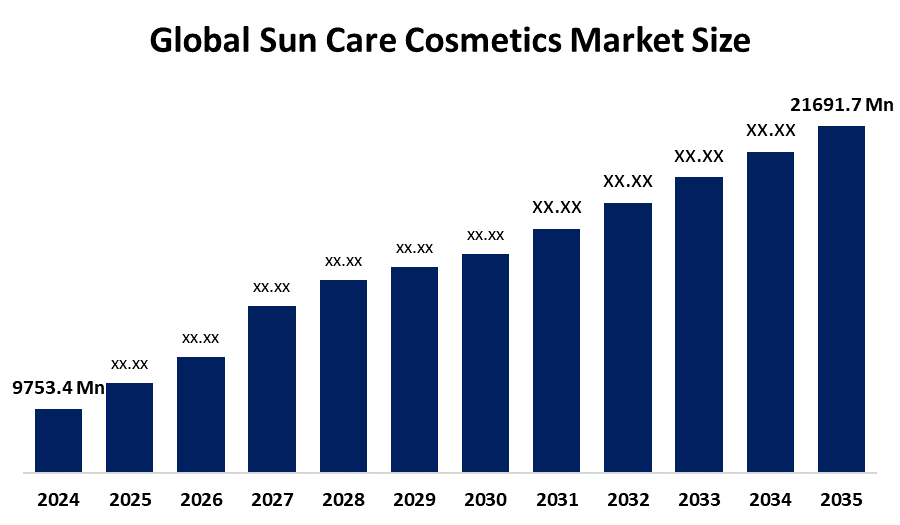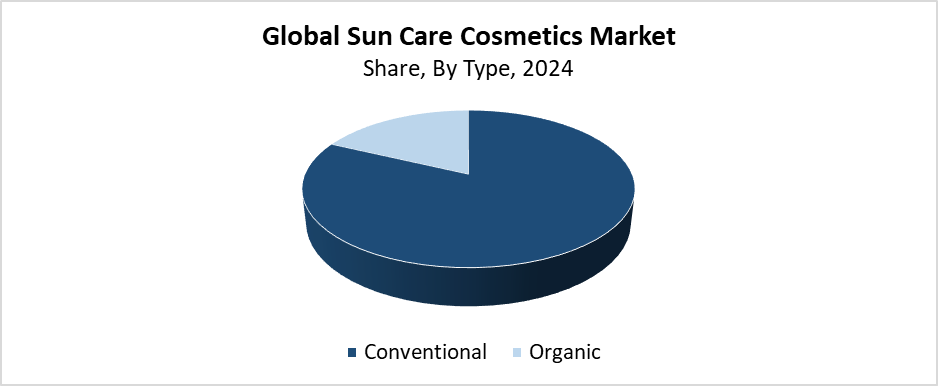Global Sun Care Cosmetics Market Size, Share, and COVID-19 Impact Analysis, By Type (Conventional, Organic), By Distribution Channel (Supermarkets & Hypermarkets, Specialty Stores, E-Commerce, Others), and By Region (North America, Europe, Asia-Pacific, Latin America, Middle East, and Africa), Analysis and Forecast 2025 - 2035
Industry: Consumer GoodsSun Care Cosmetics Market Size Summary
The Global Sun Care Cosmetics Market Size Was Estimated at USD 9753.4 Million in 2024 and is Projected to Reach USD 21691.7 Million by 2035, Growing at a CAGR of 7.54% from 2025 to 2035. The market for sun care cosmetics is expanding as a result of growing concerns about anti-aging, skin cancer incidence, and skin protection. Global warming, growing outdoor lifestyles, and the need for multipurpose products with SPF all contribute to consumer adoption and market growth.

Get more details on this report -
Key Regional and Segment-Wise Insights
- In 2024, the Asia Pacific sun care cosmetics market held a 37.25% revenue share, dominating the global market.
- In 2024, the conventional segment held the largest revenue share and led the market by type, accounting for 82.61%.
- In 2024, the hypermarkets and supermarkets segment held the largest revenue share of 48.25% and led the market by distribution channel, accounting for 31.48%.
Global Market Forecast and Revenue Outlook
- 2024 Market Size: USD 9753.4 Million
- 2035 Projected Market Size: USD 21691.7 Million
- CAGR (2025-2035): 7.54%
- Asia Pacific: Largest market in 2024
The sun care cosmetic market consists of products that include sun protection lotions and after-sun care items, which protect skin from UV radiation damage. These products serve as essential protection tools against sunburn and premature skin aging, alongside skin cancer caused by sun exposure. The expanding market receives its main growth drivers from rising consumer understanding about UV radiation dangers and increased public interest in skin health and aesthetics, and worldwide outdoor recreational expansion. The demand exists due to both climate alterations and the rising number of skin disorders, and the necessity for products that fight aging. The market has experienced significant growth through the rising interest in skincare products that offer multiple benefits, including moisturizers and cosmetics with SPF protection.
The sun care cosmetics market experiences a transformation through new formulations that deliver skin-compatible components alongside water resistance and extended protection. Advanced encapsulation techniques and nanotechnology enable researchers to enhance product effectiveness and absorption rates. The rising number of consumers selecting clean-label and environmentally friendly products drives the increasing popularity of natural and organic sunscreens. The market gains legitimacy and expansion through government regulations that establish SPF labeling standards along with skin cancer awareness programs. Educational initiatives and public health campaigns actively work to promote sunscreen usage. The worldwide sun care cosmetics market continues to grow at a steady pace because of both innovative developments and regulatory support.
Type Insights

Get more details on this report -
The conventional segment led the sun care cosmetics market by generating the largest revenue share of 82.61% in 2024. The primary factors leading to this market leadership are the widespread availability of conventional sun care products and their economical pricing, alongside their established consumer acceptance. Traditional sunscreens and lotions can be found throughout every retail channel because they maintain extensive distribution networks, which include pharmacies and supermarkets, and convenience stores. The product line includes multiple options that address different skin needs while providing SPF protection, water resistance, and broad-spectrum coverage. The well-known firms invest heavily in marketing and product development for their conventional segment to maintain their dominant market position and loyal customer base. The total market revenue still finds its leader in this category.
The organic segment of the sun care cosmetics market is expected to grow at the fastest CAGR during the projected period because of consumers increasingly buying natural, chemical-free, and environmentally friendly skincare products. The rising awareness about health dangers linked to parabens and oxybenzone has driven the shift toward organic alternatives. The products contain plant-based and mineral-based and reef-safe components, which draw customers who prioritize their health and environmental protection. The rising popularity of clean beauty and cruelty-free and vegan trends, together with the expansion of online and specialty retail channels, drives accelerated market growth. Brand investment continues to grow because of innovative organic formulations that deliver effective sun protection while being gentle to sensitive skin.
Distribution Channel Insights
The hypermarkets and supermarkets segment holds the largest revenue share of 31.48% in 2024 and dominated the sun care cosmetics market. The large customer base of these retail outlets, combined with their ability to offer both convenience and product variety, explains their market leadership in this sector. Customers visit these stores because they can inspect product labels while comparing brands and accessing both in-store price reductions and promotional deals. The large number of customers that supermarkets and hypermarkets attract helps both product visibility and spontaneous purchases. Leading sun care brands focus their distribution strategy on these retail channels to maximize their market penetration and expand their reach. The market segment generates substantial revenue because of its strong retail network and established customer loyalty.
The e-commerce sector of the sun care cosmetics market is expected to grow at the fastest CAGR because of increased internet penetration, smartphone use, and customer preference for easy purchasing options. Online shopping platforms serve as an attractive choice for customers through their extensive product inventory and detailed item information, combined with user feedback and competitive pricing. Social media marketing combined with direct-to-consumer (DTC) brands has driven higher online sales of sun care products. The demand for organic and specialty sun care products continues to grow because customers find these products more easily available through online platforms than in traditional retail stores. E-commerce drives future industry growth through its subscription-based models, seasonal discounts, and personalized product suggestions that enhance user interaction.
Regional Insights
The North American sun care cosmetics market held a significant revenue share of the global market because of rising concerns about UV radiation exposure, together with growing anti-aging product demand and improved skin health understanding. The market experiences consistent expansion because Americans and Canadians now use sun protection products as essential elements of their daily skincare routines. The market value receives a boost from renowned cosmetic brands combined with advanced product formulations and widespread distribution through physical stores and digital platforms. The combination of public health campaigns and rising skin cancer rates, along with outdoor activities, motivates people to use sunscreen regularly. The introduction of multi-functional skincare products, including moisturizers with SPF protection alongside makeup products, drives customer preferences, which leads to increased demand throughout North America.
Asia Pacific Sun Care Cosmetics Market Trends

Get more details on this report -
The sun care cosmetics market is dominated by the Asia Pacific region by generating the largest revenue share of 37.25% in 2024. The rising income levels and expanding awareness of skin protection, together with developing beauty standards in China, Japan, South Korea, and India, lead to the Asia Pacific's dominant market position. Sun protection creams enjoy wide usage throughout the area because of its intense UV exposure and the cultural preference for lighter and more even skin tones. Sun care products with multiple uses have gained popularity through K-beauty and J-beauty trends while also attracting increased innovation from consumers. The market expansion is supported by young demographics combined with growing cities and e-commerce platforms. The market lead of Asia Pacific continues to grow because domestic and international brands dedicate resources to product development and marketing efforts.
Europe Sun Care Cosmetics Market Trends
The European sun care cosmetics market grows significantly due to rising demand for premium skincare products, together with growing consumer knowledge about skin health and aging-related skin care needs. The beauty and personal care industries of Germany and France and Italy, and the United Kingdom drive major market contributions. People use sunscreen products because they enjoy outdoor activities, together with their interest in visiting sunny destinations and seasonal tourism patterns. The European Union's strict safety standards and labeling requirements for sun care products have led consumers to trust certified sun protection products more. The market segment dedicated to natural and organic, and reef-safe formulas is rising because of the growing interest in sustainability. The industry continues its steady expansion because of growing retail store networks and internet sales platforms throughout Europe.
Key Sun Care Cosmetics Companies:
The following are the leading companies in the sun care cosmetics market. These companies collectively hold the largest market share and dictate industry trends.
- Beiersdorf AG
- The Clorox Company
- L'Oréal Groupe
- Johnson & Johnson Services, Inc.
- Unilever
- Shiseido Company Ltd.
- Groupe Clarins
- Coty Inc.
- The Estée Lauder Companies Inc.
- Naos
- Others
Recent Developments
- In June 2025, Beiersdorf Nigeria introduced a customized NIVEA UV Face Sunscreen designed to meet the particular requirements of African skin. To raise awareness of the value of daily sun protection, the product was unveiled at an event in Lagos. Sunscreen helps avoid problems, including hyperpigmentation, premature skin aging, and the growing risk of skin cancer, because of Nigeria's high UV exposure. It is made for daily use and works well with makeup, and it is aimed at adults between the ages of 25 and 45. The event's health experts also cautioned against using dangerous skin-lightening cosmetics and emphasized the risks of unprotected sun exposure.
- In March 2025, to promote its Ultra Sheer Mineral Face Liquid Sunscreen SPF 70, Neutrogena unveiled a new campaign with actor and wrestler John Cena. Cena's well-known line, "You Can't See Me," is cleverly parodied in the campaign to emphasize the sunscreen's lightweight, invisible formula that doesn't leave any white residue behind.
Market Segment
This study forecasts revenue at global, regional, and country levels from 2020 to 2035. Spherical Insights has segmented the sun care cosmetics market based on the below-mentioned segments:
Global Sun Care Cosmetics Market, By Type
- Conventional
- Organic
Global Sun Care Cosmetics Market, By Distribution Channel
- Supermarkets & Hypermarkets
- Specialty Stores
- E-Commerce
- Others
Global Sun Care Cosmetics Market, By Regional Analysis
- North America
- US
- Canada
- Mexico
- Europe
- Germany
- UK
- France
- Italy
- Spain
- Russia
- Rest of Europe
- Asia Pacific
- China
- Japan
- India
- South Korea
- Australia
- Rest of Asia Pacific
- South America
- Brazil
- Argentina
- Rest of South America
- Middle East & Africa
- UAE
- Saudi Arabia
- Qatar
- South Africa
- Rest of the Middle East & Africa
Need help to buy this report?